Every game eventually reaches a point at which it stops teaches and expects you to function on your own steam: To take the lessons you’ve learned and apply them, or fail. Even games like Final Fantasy XIII and modern Zeldas do this, although in those cases it may not come until the very end.
Castlevania III doesn’t wait that long. The end of Block 5 marks the game’s midpoint, regardless of which route you’ve traveled — the fifth block of 10 — and it’s here that you find a sharp spike in difficulty, even in light of the challenges that previous stages have thrown your way. Block 5 serves as the sink-or-swim point of Dracula’s Curse, and in fact this is the point at which my attempts to play back-to-back sessions with every combination of characters ground to a halt on my second runthrough. The added brutality of the New Game + cycle on top of this block’s already crushing difficulty made me throw in the towel.
That being said, this level seems to have been designed to take particular advantage of Sypha’s skills. It’s not a cakewalk even with her taking the lead, but cautious play and proper use of her spells (conveniently handed out at all the right moments) will take you far.
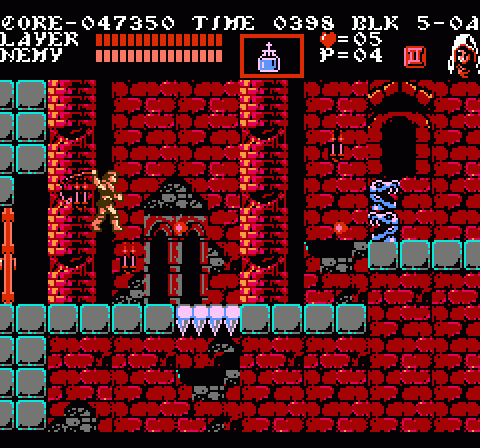
Block 5 is known as the Tower of Terror — basically the outer wall of Castlevania, accessed by taking the ghost ship across the lake — and as such feels like a sort of “expert mode” version of the previous tower, the optional clock tower of Block 2. While it lacks gears and Medusa Heads, it employs similar (yet more evil) tricks.
You can see this stage’s “cruel twists on familiar elements” philosophy in action the instant you begin the stage. A few steps ahead of you is one of those flip platform segments from Block 1-02 — except this time, the platform’s underside is lined with spikes. So not only does it pose a falling hazard if you jump or are knocked back onto one and don’t spring away immediately, it also become an unsafe surface once it rotates.
Unlike in previous stages where new danger appears in a fairly innocuous context, here it poses a potential threat right away. The dragon cannon that sits on the edge of the platform ahead blocks your forward progress, and you have to jump and attack it unless you’re freshly arriving from Block 4-0D with a good subweapon in hand. Mess up your timing and the cannon’s fireballs with knock you right back into the platform. This proves to be especially devious if you die before reaching Block 5-0B, since you’ll start back here with no whip upgrades, no subweapons, and no spells, meaning you need to put yourself at greater risk here in order to whittle the cannon’s health away with a stubby, weak whip.
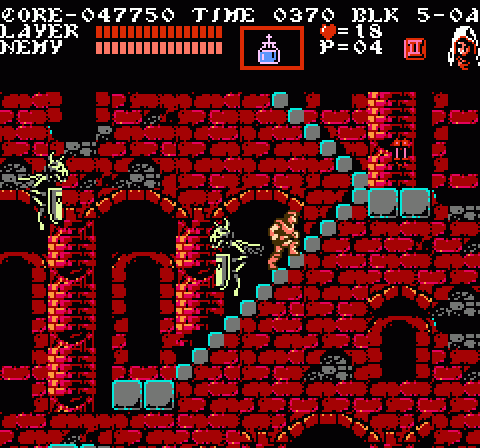
The second segment of Block 5-0A sends you on a vertical ascent. Rather than consisting of short stairways and blocks to climb by jumping, most of this sequence consists of uninterrupted stairs. This leaves you incredibly vulnerable to enemy attack, since you move slowly and your actions are more limited. Thanks to the game’s control scheme — you press up to climb and up plus attack to use a subweapon — it can be very difficult to use a subweapon attack while facing in the stairs’ downward direction (unless you hit the timing perfectly, you’ll turn to face upward before using your subweapon).
To make this sequence particularly cruel, the foes you face here behave like Medusa Heads on steroids. The skeleton gargoyles fortunately take only a single hit to defeat, but their movement puts a new and more challenging spin on the Medusa Heads’ sine-wave pattern. They rise and dip slightly, then repeat much more dramatically, with their second undulation taking them much further from the baseline of their forward path and thus making them a lot hard to hit. In some situations, this allows you to pass safely over or beneath them, but in others this puts you directly on their path but causes their approach to come from a far steeper angle that leaves you only a split second to hit them.
With Medusa Heads, Trevor could usually just fling his whip forward and the foes would drift directly into it, since their movements never took them far from the center line of their flight path. Here, though, the whip tends to be a liability. Because it has a brief wind-up frame and a relatively lengthy extension time, Trevor remains motionless and vulnerable when fighting the gargoyles on the stairs. Both Sypha and Grant fare much better despite their poor range, because they attack immediately with no wind-up.
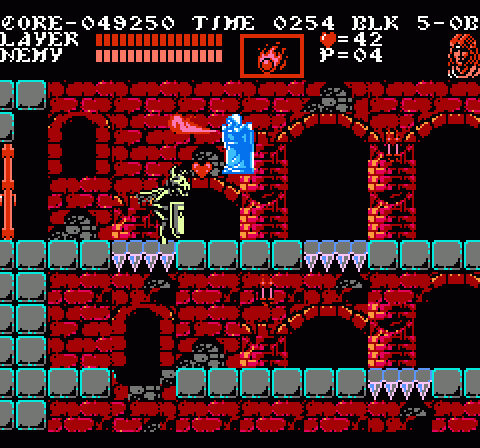
Beyond the stairs lies Block 5-0B, which is even crueler. The seemingly endless stairs give way to a complex series of platforms and short stairs that wouldn’t be too difficult on their own — but here the tower scrolls automatically upward, shifting several block upward every few seconds and constantly threatening to send the protagonists plummeting to their doom below the bottom of the screen. This is one case where Grant can’t simply skip past the challenges, because the screen advances as a set rate, ratcheting forward, and enemies above don’t appear until the level has advanced far enough to bring them fully onto the screen. Getting ahead of the scrolling here is therefore a very bad idea, since it puts you at risk of standing in a “safe” spot only to have a bad guy materialize on top of you with the next ratchet.
What does work well? Sypha’s ice magic, conveniently provided at the beginning of Block 5-0B. Ice spells radiate in five directions ahead of, above, and behind Sypha’s head. The spell may not have much range, but anything it strikes instantly freezes in place for several seconds — and, better yet, Sypha can strike a frozen foe (no matter how strong) with her staff and instantly shatter it. Given that most of the threats here come from above and generally take the form of armored knights that would take Trevor several attacks to finish off, you can see the value of ice magic. It doesn’t quite trivialize this area, since you still have to stay ahead of the scrolling and freezing enemies requires careful timing so they don’t thaw right as you approach them, but nevertheless you’ll have a vastly easier time if you freeze your foes.
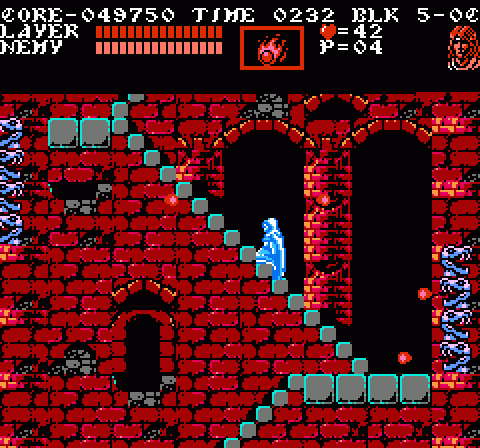
This brings us to Block 5-0C, which offers up what well may be the single most difficult sequence to have appeared in the Castlevania series to this point. The autoscrolling subsides to be replaced by more length staircases. Here you don’t face gargoyles, though; rather, you have to climb through a gauntlet of dragon cannons, which spit fire at you as you trudge your way slowly upward. Some of the cannons are arranged so you can position yourself safely between their blasts, but others offer no such courtesy and the only way to climb safely is to provoke them to fire in near-tandem, retreat, and rush as best as you can to safety. Making it through here unscathed is the mark of a true Castlevania expert.
Unless you’re using Sypha, who can pick up her lightning spell at the beginning of the segment. Lightning lacks the hair-singing power of the fire spell, packing only as much punch as Trevor’s upgraded whip, and it doesn’t immobilize or destroy foes instantly like ice. But it does have exceptional range — in fact, it’s the only skill in the game capable of hitting an enemy anywhere on screen. The lightning spell consists of three small orbs of energy that fly out and instantly seek any enemy. The three balls follow independent paths and will automatically target a different foe. And each blast costs only a single heart.
That doesn’t mean Sypha can just throw lightning indiscriminately, though; the spell balls aren’t very smart and will just as happily pursue the cannon’s fireballs off-screen as target the cannons themselves. Some measure of timing is essential to take down the cannons without totally squandering your stock of hearts. Still, this one spells transforms this sequence from “almost unfair” to “slow going but not at all unreasonable.”
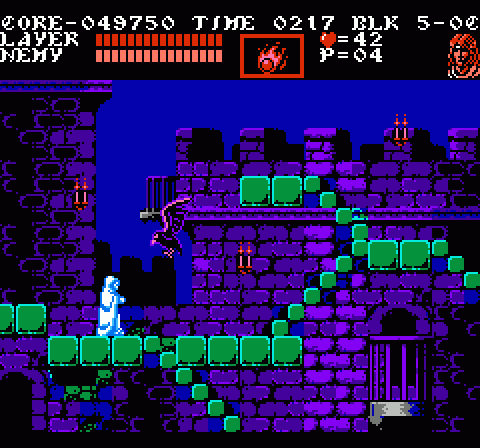
Once you reach the top of the tower, you climb to the exterior. A simple palette shift from warm reds to deep purples delivers the impression of exiting an interior lit by torches into night air soaked by darkness. The series’ admirable attention to detail really shines here, as this darkened space only spans two screens before you reach the adjacent tower alcove where the boss waits and the level ends. The block could just as easily have ended inside the tower and consisted entirely of the red brick hues, but by simply throwing in this little coda the level designers convey a sense of place and structure to the quest.
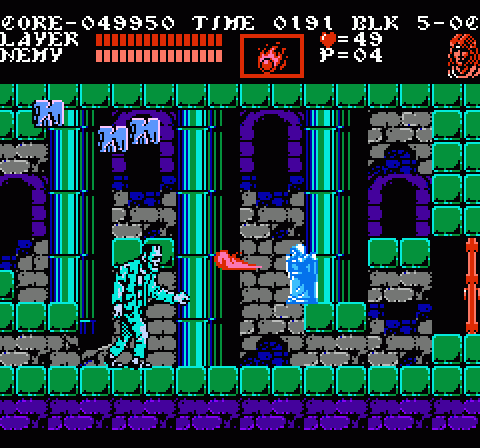
At the end of the stage, you face the boss: Frankenstein’s monster. This game taking place hundreds of years before the original Castlevania, the Creature hasn’t yet recruited Igor. Instead, he stomps his foot to dislodge masonry that falls from above. You can stay out of the way by sticking to the upper-right platform, where blocks rarely fall… but then you can’t hit the Creature, while he can chuck stones to hit you. Sypha’s lightning spell works well enough, leaving you free to dodge the occasional block he throws, but a more aggressive and direct approach also works since he reels backward when struck and therefore can be kept from getting in your face too much on the right side of the screen. This can be a tough fight if you don’t cheese it with lightning, but it still feels a lot more fair than the Creature encounter in Castlevania.
Still, fighting Frankenstein’s monster at the halfway point? It makes you wonder what other grim threats Castlevania III has in store for its second half. Quite a few, as it turns out.
(As ever, thanks to VG Museum for graciously letting me swipe its collection of Castlevania III images for these posts.)
A couple years ago I bought Castlevania III on Virtual Console to try it out, since I was too young for the NES entries when they originally came out. I got to this stage and lost my will to live, or at least keep playing. I was weaned on Super Castlevania IV, almost literally as it was the first game I ever played, and I still can’t deal with the NES games’ terrible controls and brutal difficulty. Why can’t I jump onto stairs!?
I have to admit, reading of Sypha’s usefulness here is giving me new respect for the character. Any chance Alucard might do the same, even if he may not be as good as Sypha?
I actually did a Grant-only run on the Japanese version recently, and he had a very easy time with this area. The ratchet-scrolling area was easily thwarted by staying about halfway down the screen and climbing further up when it scrolled, and the long-range knife he gets in the Japanese version allows him to deal with the dragon cannons fairly easily by focusing on one at a time. It was definitely slow going, but it wasn’t as balls-destroyingly hard as you imply here.
This is not an analysis of the Japanese version.
Plus he could go under the platforms to the right and then crouch down to hit Frankenstein over and over while remaining fairly safe himself.
Strange…I thought we would be seeing the other Block 4 this update. I take it the game anatomy’s gonna cover one route through the game, then come back for the other stages later? How’s Block 6 gonna pan out with its three versions?
But I digress. Block 5-Alt is actually new to me, if only because I tend to bail Block 3 early because I’ve been more successful making progress past Block 4 than 4-Alt. It’s nice that CV3 has replay value like that with its alternate stages and characters.
From a few days back: “We’ll be following the path we saw a portion of yesterday to its conclusion before exploring the alternate route.” Read to succeed!
I can’t imagine the level would be that much harder in the American version. You might need to switch to Trevor to deal with the Skull Cannon staircase or Frankenstein, but Grant would still break the ratchet section. And hell, you can still get him the dagger subweapon to deal with the Skull Cannons.
It’s OK, dude. I never said Grant sucks, and in fact have pointed out how he can be useful. You don’t have to defend his honor against attacks that never happened after every post in this series.
Well, my logic is that you don’t really seem to use Grant all that much, and since he’s my favorite partner I feel like I can add some extra insight into using him. I’m not defending him, per se, just filling gaps in your articles.
You do realize that this series is a work in progress, right? And that I’m planning to flesh out the topics I haven’t addressed in later posts?
Okay, in that case I’ll back off. Sorry if I seemed too pushy about this. Love the series, btw.
Lilfut, give it a rest. Write your own series if you want, but I don’t think there are any “gaps” needing to be filled here.